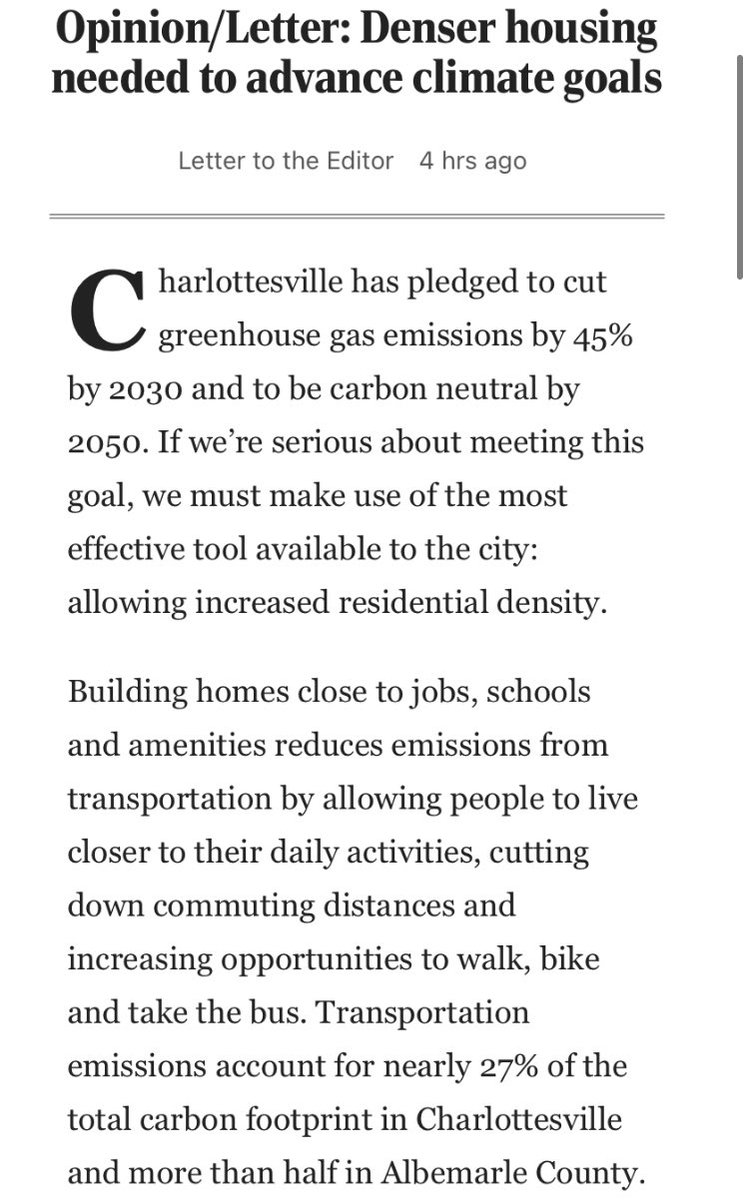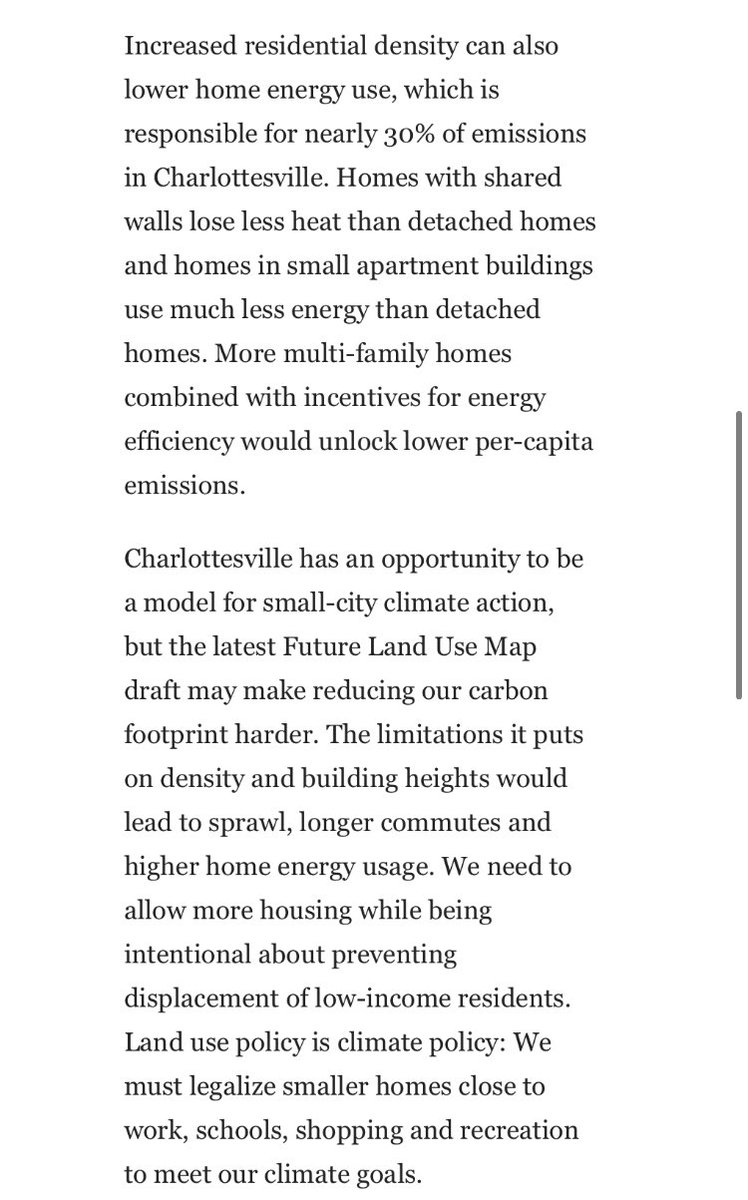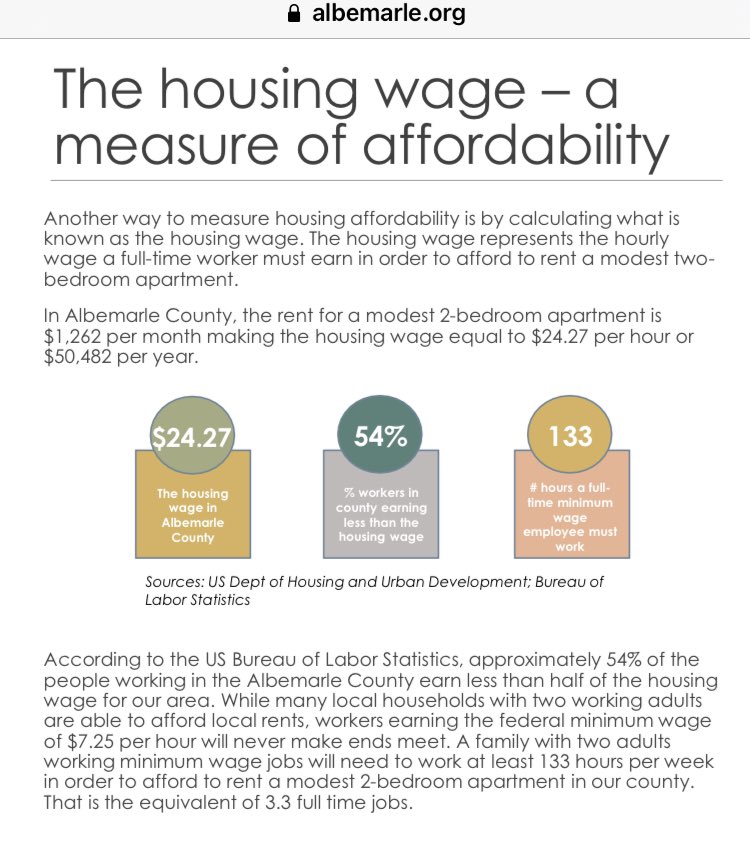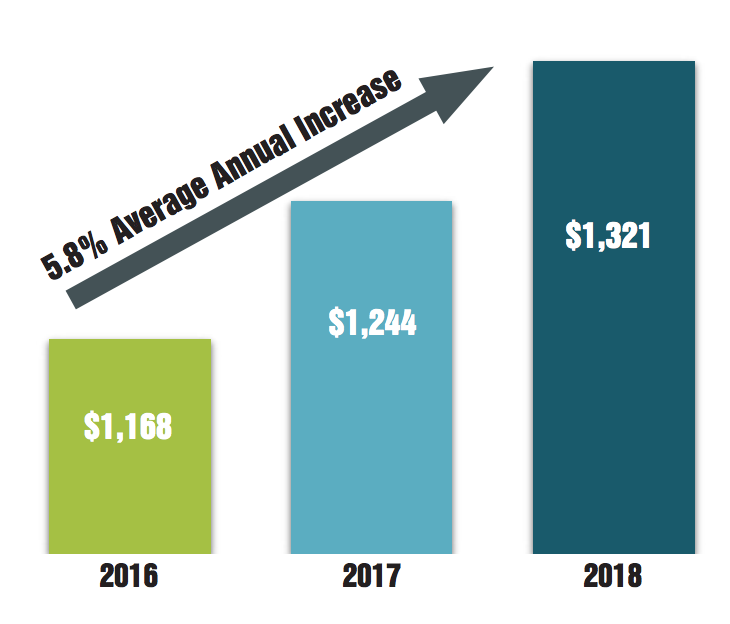
Do you have questions about housing in Charlottesville as we move through the @CvillePlans process? We put together a resource that we hope will help provide answers as we seek to fix our community’s housing crisis. Let us know what you think!
bit.ly/3mFhBiW
bit.ly/3mFhBiW

We tried to answer 16 questions we’ve heard come up. In case reading a PDF isn’t for you, we will thread them out.
First question: Does Charlottesville really have a housing crisis?
Answer: Yes! Depending on the analysis, as many as 4300 households - nearly a quarter - Charlottesville are “cost burdened,” meaning they spend over 30% of their income on housing.
Answer: Yes! Depending on the analysis, as many as 4300 households - nearly a quarter - Charlottesville are “cost burdened,” meaning they spend over 30% of their income on housing.
See @CLIHC_Cville’s report “The Impact of Racism on Affordable Housing in Charlottesville” for more on those numbers.
justice4all.org/wp-content/upl…
justice4all.org/wp-content/upl…
Fair market rent in the Charlottesville area is the highest in the state outside of Northern Virginia. vhda.com/BusinessPartne…
In some areas of the city more than 50% of renters
are cost-burdened.
See the city’s 2018 “Housing Needs Assessment” for more: charlottesville.gov/DocumentCenter…
are cost-burdened.
See the city’s 2018 “Housing Needs Assessment” for more: charlottesville.gov/DocumentCenter…
This issue affects community members across a range of ages, incomes, and backgrounds.
cvilletomorrow.org/articles/affor…
cvilletomorrow.org/articles/affor…
Home ownership is increasingly out of reach for many in the community. Charlottesville’s housing crisis is consistent with trends in our region and many other parts of Virginia. tjpdc.org/wp-content/upl…
Second question: What is the Future Land Use Map (FLUM) and how does it relate to the Comprehensive Plan?
Answer: The FLUM is a document that helps define where and how
the city will grow over time. It is used as a basis for the zoning code. uwsp.edu/cnr-ap/clue/Do…
Answer: The FLUM is a document that helps define where and how
the city will grow over time. It is used as a basis for the zoning code. uwsp.edu/cnr-ap/clue/Do…
The FLUM helps to guide which rezonings should or should not be approved. It does not compel any sort of development to occur. It is one part of Charlottesville’s Comprehensive Plan cvilleplanstogether.com/citywide-compr…
It is intended to be consistent with the Affordable Housing Plan that City Council approved in March 2021.
drive.google.com/file/d/1GVLEMl…
drive.google.com/file/d/1GVLEMl…
Third question: Has this process been rushed? Have there been adequate opportunities for community input?
Answer: The process has not been rushed — it has taken 4 years at this point and probably has at least another year to go.
Answer: The process has not been rushed — it has taken 4 years at this point and probably has at least another year to go.
The Planning Commission started revising the current Comprehensive Plan in 2017. In 2019, the city hired consulting firm Rhodeside and Harwell (RHI) to build off the Planning Commission’s work.
RHI was tasked with completing the Comprehensive Plan, developing an Affordable Housing Plan, and rewriting the zoning code via a process dubbed “Cville Plans.
cvilleplanstogether.com
cvilleplanstogether.com
A steering committee represent- ing various communities and organizations in Charlottesville has met since January 2020. 

Multiple opportunities for community outreach have occurred so far: mid 2020, fall 2020, & spring 2021. There will be further public input on the FLUM, the Comp Plan, and eventually the zoning rewrite as the process moves along. Further delay will worsen our housing crisis.
There was even more public input prior to all of this
https://twitter.com/LyleSollaYates/status/1431992611556966401
Fourth question: Will increased density result in more affordable housing?
Answer: Allowing more housing types doesn’t guarantee every unit will be affordable, but banning many types of multi-family housing makes building affordable housing nearly impossible.
Answer: Allowing more housing types doesn’t guarantee every unit will be affordable, but banning many types of multi-family housing makes building affordable housing nearly impossible.
Detached single-family homes are the most expensive homes in Charlottesville: on average, they cost 50% more than townhomes and twice as much as units in duplexes.
https://twitter.com/cvilleneighbors/status/1405630348239777793
We need to allow smaller, more affordable homes at a variety of price points to take pressure off neighborhoods like Fifeville and 10th & Page. npr.org/2021/07/30/102…
Of note, an affordable housing overlay has been proposed
to tie increased density to the inclusion of affordable units. cvilletomorrow.org/articles/housi…
to tie increased density to the inclusion of affordable units. cvilletomorrow.org/articles/housi…
We need to get rid of things that unnecessarily drive up housing costs, like parking requirements, excessive setbacks, and bureaucracies that slow the construction of housing and drive up the cost of construction.
https://twitter.com/aaronAcarr/status/1420879641997418500
Fifth question: What can be done to prevent displacement of low-income residents?
Answer: It will take multiple strategies to reduce displacement of low-income residents of Charlottesville.
Answer: It will take multiple strategies to reduce displacement of low-income residents of Charlottesville.

Broadly speaking, anti-displacement efforts fall under three categories: housing production, preservation, and neighborhood stabilization. urbandisplacement.org/sites/default/…
While new housing production is key, at the same time new development should be focused in places where there is reduced impact on low-income families, such as in affluent downtown neighborhoods and in student housing areas along JPA and 14th Street. escholarship.org/uc/item/5d00z6…
High impact solutions for preservation include ensuring unsubsidized affordable housing is available and giving the community control of its land.
Rental assistance programs, foreclosure assistance, tenant right to counsel, and “just cause” eviction laws help stabilize neighborhoods and prevent displacement. localhousingsolutions.org/housing-policy…
Charlottesville should work to implement the above solutions and advocate at the state and federal level when necessary.
6th question: How can we achieve affordability for people with very low incomes?
Answer: More market-rate housing on its own won’t be enough for low-income families because often even inexpensive market-rate housing is unaffordable to low-income families.
urbandisplacement.org/sites/default/…
Answer: More market-rate housing on its own won’t be enough for low-income families because often even inexpensive market-rate housing is unaffordable to low-income families.
urbandisplacement.org/sites/default/…
That’s why we also need increased federal, state, and local funding for housing subsidies and stronger tenant protections to help vulnerable tenants avoid eviction, all of which are called for in Charlot- tesville’s Affordable Housing Plan.
Money spent subsidizing housing will stretch further if we don’t have a housing shortage. And allowing more multi-family homes will enable non-profit housing developers to build more low-income housing without having to go through a lengthy (and expensive) review process.
7th question: Won’t this all just benefit developers and real estate investors?
Answer: No. Outside investors and existing landlords benefit from housing scarcity: Owners of apartment buildings uniformly cite new construction as a risk to their business.
Answer: No. Outside investors and existing landlords benefit from housing scarcity: Owners of apartment buildings uniformly cite new construction as a risk to their business.
They have a harder time raising rents when there are more competing properties for tenants to choose between. Invitation Homes, the largest single-family rental landlord in the country, says construction of new apartments is a threat to its business. d18rn0p25nwr6d.cloudfront.net/CIK-0001687229…
Why? Because development would give its customers — people who need a place to live — too many other options. Multi-family housing is more affordable than single-family housing. Allowing more multi-family housing benefits families who can’t afford a detached house.
It’s true that developers make money building new housing, but if we don’t allow more multi-family housing, developers will instead make money building luxury single-family homes and flipping older homes while driving up prices.
8th question: Will the proposed land use map lead to the construction of large apartment buildings like on West Main Street in my neighborhood?
Answer: The draft FLUM would allow up to 2 or 3-family homes in much of the city and small apartments in a few neighborhoods.
Answer: The draft FLUM would allow up to 2 or 3-family homes in much of the city and small apartments in a few neighborhoods.
It wouldn’t force anyone to build denser housing. Our zoning ordinance describes the maximum density for a property, but homeowners and developers are free to build less than the maximum if they choose.
drive.google.com/drive/mobile/f…
drive.google.com/drive/mobile/f…
The current rules say only detached single-family homes — the most expensive housing type — can be built in the vast majority of residential areas in the city.
9th question: Don’t we have too much new construction in Charlottesville?
Much of the new construction you see in Charlottesville every day is office buildings or businesses, not homes. We’re building relatively few homes each year — just 130 in 2020.
dailyprogress.com/news/local/gov…
Much of the new construction you see in Charlottesville every day is office buildings or businesses, not homes. We’re building relatively few homes each year — just 130 in 2020.
dailyprogress.com/news/local/gov…
Instead, new construction is primarily to accommodate employers who see Charlot- tesville as a great place to do business. We’re not building to accommodate the people who make those workplaces go.
In the last 30 years, our region added 35,000 jobs and 7,500 UVA students, but only 7,000 more residents in the city — a 17% increase. fred.stlouisfed.org/series/LAUMT51…
During the same time period the population of Albemarle County grew 62%, Louisa County 85%, Greene County 100%, Orange County 76%, Augusta County 39%, and Fluvanna County 117%.
Lack of housing near job centers drives up household spending on transportation as people pursue more affordable housing in the surrounding areas.
tjpdc.org/wp-content/upl…
tjpdc.org/wp-content/upl…
Charlottesville’s lack of housing is consistent with patterns in many growing areas throughout the United States: It has been estimated the U.S. needs somewhere between 3.8 million and 5.5 million new homes broadly speaking.
Furthermore, our country needs 6.8 million rental homes for very low income individuals. reports.nlihc.org/gap
10th question: It feels like the city is going about this alone. Don’t Albemarle County and UVA have a role to play?
Answer: Albemarle County and UVA certainly have a role to play; this is a regional issue.
Answer: Albemarle County and UVA certainly have a role to play; this is a regional issue.
The Affordable Housing Plan approved by City Council
in March 2021 calls on both Albemarle County and UVA to change the way they approach affordable housing, land use, racial inequality and tenant protections. drive.google.com/file/d/1GVLEMl…
in March 2021 calls on both Albemarle County and UVA to change the way they approach affordable housing, land use, racial inequality and tenant protections. drive.google.com/file/d/1GVLEMl…
UVA is planning to build 1,000 to 1,500 affordable homes on university-owned land over the next decade. UVA is also planning to expand on-campus housing to include all second-year students, which could help free up some housing in the city. nbc29.com/2021/04/29/uva….
Albemarle County has been working on its affordable housing plan and the Board of Supervisors has committed to supporting policies related to affordable housing. dailyprogress.com/news/local/gov…
11th Question: Will increased density increase traffic?
Answer: People will have to drive less and drive fewer miles if we build more homes close to our jobs. Thousands of employees already commute from surrounding counties to jobs in Albemarle & Cville.
statchatva.org/2017/05/08/vis…
Answer: People will have to drive less and drive fewer miles if we build more homes close to our jobs. Thousands of employees already commute from surrounding counties to jobs in Albemarle & Cville.
statchatva.org/2017/05/08/vis…
Development patterns in our area have contributed to car dependency and increased traffic by putting homes far away from work, schools, and shopping. Every person who can walk, bike, or take the bus to work is one fewer car on the road during rush hour.
strongtowns.org/journal/2018/1…
strongtowns.org/journal/2018/1…
The EPA found that infill development reduces traffic congestion and car emissions, and studies indicate increased proximity often results in a decrease in traffic.
epa.gov/smartgrowth/me…
epa.gov/smartgrowth/me…
A key to reducing congestion on Charlottesville roads is in- creasing local transit ridership. @RideWithCAT is taking steps to make that happen by becoming fare free, improving route efficiency, adding buses to increase frequency, and expanding park and ride options.
12th Question: Will increased density hurt the environment?
Answer: No. In fact, allowing more multifamily homes is the single best thing Charlottesville can do to fight climate change.
Answer: No. In fact, allowing more multifamily homes is the single best thing Charlottesville can do to fight climate change.
Research from Cal-Berkeley has found that population-dense areas contribute significantly fewer greenhouse gas emissions than suburban areas.
news.berkeley.edu/2014/01/06/sub…
news.berkeley.edu/2014/01/06/sub…
Furthermore, single-family homes are not particularly good for the environment. Larger detached single-family homes are among the largest contributors of residential greenhouse gas emissions in the U.S. pnas.org/content/117/32…
And multi-family homes use significantly less energy over time compared to detached single-family homes. oregon.gov/deq/FilterDocs…
13th question: Do we have adequate water infrastructure if the city’s population increases?
Answer: Yes. The Rivanna Water and Sewer Authority has said the area’s urban water supply will be adequate until around 2060. dailyprogress.com/news/local/wat…
Answer: Yes. The Rivanna Water and Sewer Authority has said the area’s urban water supply will be adequate until around 2060. dailyprogress.com/news/local/wat…
Plans are already underway to expand capacity before 2060. rivanna.org/wp-content/upl…
14th question: What about overcrowding in the city schools?
Answer: The school system has anticipated increased enrollment and is in the process of a major reconfiguration that will create a preschool center at Walker and turn Buford into a 6th-to-8th grade middle school.
Answer: The school system has anticipated increased enrollment and is in the process of a major reconfiguration that will create a preschool center at Walker and turn Buford into a 6th-to-8th grade middle school.
The most recent major CCS facilities update was 47 years ago in 1974, when Charlottesville High School was built. According to a 2017 capacity study, elementary school expansion eventually will be necessary, though enrollment growth has slowed since 2017. charlottesvilleschools.org/wp-content/upl…
Additional density will likely lead to increased enrollment, but a larger residential tax base will help pay for additional school expansion. Cville’s aging schools are not unique in Virginia & momentum is building for additional state funding for school facility improvements.
• • •
Missing some Tweet in this thread? You can try to
force a refresh
















